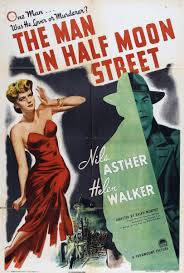
Dr. Julian Karell (Nils Asther) is a doctor, painter and, overall, a man of many accomplishments. Karell is also 120 years old but looks to be in his thirties. The reason for his youthful appearance is that Karell has discovered, through the use of glandular transplants, a way to prolong human life. The main problem with the process is that it kills the donor. In order to maintain his youth, Karell must undergo the procedure every ten years. As a result, over the decades, there have been unusual murders in London that have never been solved. What is known is that they happen every ten years and have been attributed to a serial killer.
Karell has fallen in love with Eve Brandon (Helen Walker). Her father, Sir Humphrey Brandon (Edmund Breon), is a little suspicious of the man his daughter is in love with and keeps an eye on the man. Karell, having been alone for the last ninety years, now faces the problem of telling Eve about his past. It has also been ten years since his last procedure. If he doesn’t have an operation soon, he will revert to his actual age. Brandon family friend, Dr. Henry Latimer (Paul Cavanagh), becomes suspicious of Karell’s experiments and contacts Scotland Yard. Karell’s fingerprints are surreptitiously taken. The results reveal that his prints are the same as those of the serial killer who was never caught. The compared fingerprints go back to 1876.
Helping Karell in his search for youth is Dr. Kurt van Bruecken (Reinhold Schunzel). Bruecken did not use himself as a guinea pig and so he continued to age. Karell has become obsessed with his youth and no longer looks at the experiments as the pursuit of science and the advancement of humanity. Bruecken has become disillusioned with the change in Karell. That and a stroke he suffered previously have left Bruecken unable to perform the surgery needed to prolong his associate’s life.
With Bruecken out of commission and Scotland Yard scrutinizing his every move, Karell is being pushed into a corner he may not be able to get out of.
“The Man In Half Moon Street” was released in 1945 and was directed by Ralph Murphy. It is an American romantic melodrama with science fiction undertones and noir elements. The plot is similar to “The Picture of Dorian Gray” 1945 and Hammer’s “The Man Who Could Cheat Death” 1959, the pursuit of eternal youth. The film is based on the 1939 Barre Lyndon play of the same name.
As far as mad scientists are concerned, in this case, there is very little ranting and raving. Equally there are very few dark and spooky laboratories and not a wiz bang to be seen. The movie doesn’t focus on the murders committed to get the glands needed for the youth serum but in the mental deterioration of Karell in his pursuit of immortality. In my opinion, the reason Half Moon is not more popular is because nothing really happens to keep your attention. The standard glandular experiment plot, although well worn, is not put to any good use here. There are no operations performed and no on-screen murders. Just about everything you know about Karell, and his experiments are conversational.
What started out as a horror-esque science fiction story ends up being an average yet talkie melodrama. I was a little disappointed.

